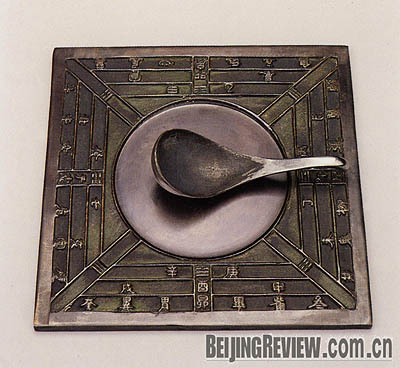|
Zheng He's expeditions navigated the "Silk Road" on the sea, during the reign of Emperor Yongle in the Ming Dynasty (1368-1644).
Emperor Yongle believed in an open-door policy in international diplomacy and trade. He sent Zheng on overseas voyages to make China's strength known to the world and to spread Chinese culture. Zheng's team used the compass and position of the stars to navigate their way across the world, from the South Pacific, Indian Ocean and Persian Gulf to Africa in seven epic voyages from 1405 to 1433, 80 years earlier than Columbus' accomplishments.

GIVING DIRECTIONS: The early form of the compass, Si Nan featured a magnetized ladle
The compass was based on a device called Si Nan during the Warring States period (453B.C.-221B.C.). Si Nan was a ladle-like magnet on a plate with the handles of the ladle pointing to the south. The early form of the compass was a magnetized needle floating in a bowl of water, or "wet compass," invented in ancient China sometime before 1044.
Explosive delights
Gunpowder was represented in the ceremony by the spectacular fireworks displays. Following the countdown, 29 massive firework footprints lit up the night sky, marching all the way from Tian'anmen Square to the National Stadium, along the city's north-south axis, symbolizing 29 Olympic Games.
The invention of gunpowder was credited to Chinese alchemists in the ninth century searching for an elixir of immortality. It is the mixture of potassium nitrate, sulfur and charcoal-elements that people took as medicine in ancient times, hence the name "huo yao" in Chinese means "burning medicines." Gunpowder was used in wars in the early 10th century, and the earliest surviving recipes for explosives can be found in the Chinese military treatise Wujing Zongyao of 1044. | 